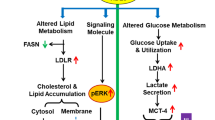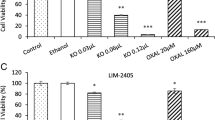Abstract
Aims
Much evidence indicates the association between dietary fat and colorectal cancer risk. However, most of the studies focus on polyunsaturated fatty acids, and little is known about the role of monounsaturated ones and their precise mechanism of action. Being store-operated Ca2+ entry (SOCE) a Ca2+ influx pathway involved in the control of multiple cellular and physiological processes including cell proliferation, we studied the effect of oleic acid in Ca2+ signals of colorectal cancer cells, paying particular attention to SOCE.
Methods
Carbachol was used to induce SOCE in Fura 2-loaded HT29 cells. We tested a saturated fatty acid to compare the physiological relevance of our results.
Results
We show that oleic acid is a potent inhibitor of SOCE. By contrast, stearic acid failed to have a SOCE-inhibitory effect. The SOCE-inhibition induced by oleic acid was protein kinase C-independent and restored by albumin. We also demonstrated that oleic acid induced increases in [Ca2+]i. The novelty of our report is that little variability in the concentration could end in a large different physiological effect.
Conclusions
In conclusion, we suggest a physiological pathway for the beneficial effect of oleic acid in colon carcinoma cells.






Similar content being viewed by others
References
Colditz GA, Samplin-Salgado M, Ryan CT, Dart H, Fisher L, Tokuda A, Rockhill B (2002) Harvard report on cancer prevention, volume 5: fulfilling the potential for cancer prevention: policy approaches. Cancer Causes Control 13(3):199–212
World Cancer Research Fund/American Institute for Cancer Research (2007) Food, nutrition, physical activity, and the prevention of cancer: a global perspective. Washington, DC
Bartsch H, Nair J, Owen RW (1999) Dietary polyunsaturated fatty acids and cancers of the breast and colorectum: emerging evidence for their role as risk modifiers. Carcinogenesis 20(12):2209–2218
Kolonel LN, Nomura AM, Cooney RV (1999) Dietary fat and prostate cancer: current status. J Natl Cancer Inst 91(5):414–428
Caygill CP, Charlett A, Hill MJ (1996) Fat, fish, fish oil and cancer. Br J Cancer 74(1):159–164
Giovannucci E, Willett WC (1994) Dietary factors and risk of colon cancer. Ann Med 26(6):443–452
Hursting SD, Thornquist M, Henderson MM (1990) Types of dietary fat and the incidence of cancer at five sites. Prev Med 19(3):242–253
Rao CV, Hirose Y, Indranie C, Reddy BS (2001) Modulation of experimental colon tumorigenesis by types and amounts of dietary fatty acids. Cancer Res 61(5):1927–1933
Chang WL, Chapkin RS, Lupton JR (1998) Fish oil blocks azoxymethane-induced rat colon tumorigenesis by increasing cell differentiation and apoptosis rather than decreasing cell proliferation. J Nutr 128(3):491–497
Minoura T, Takata T, Sakaguchi M, Takada H, Yamamura M, Hioki K, Yamamoto M (1988) Effect of dietary eicosapentaenoic acid on azoxymethane-induced colon carcinogenesis in rats. Cancer Res 48(17):4790–4794
Reddy BS, Sugie S (1988) Effect of different levels of omega-3 and omega-6 fatty acids on azoxymethane-induced colon carcinogenesis in F344 rats. Cancer Res 48(23):6642–6647
Colomer R, Menendez JA (2006) Mediterranean diet, olive oil and cancer. Clin Transl Oncol 8(1):15–21
Trichopoulou A, Lagiou P, Kuper H, Trichopoulos D (2000) Cancer and mediterranean dietary traditions. Cancer Epidemiol Biomarkers Prev 9(9):869–873
Macquart-Moulin G, Riboli E, Cornee J, Charnay B, Berthezene P, Day N (1986) Case-control study on colorectal cancer and diet in Marseilles. Int J Cancer 38(2):183–191
Stoneham M, Goldacre M, Seagroatt V, Gill L (2000) Olive oil, diet and colorectal cancer: an ecological study and a hypothesis. J Epidemiol Community Health 54(10):756–760
Bartoli R, Fernandez-Banares F, Navarro E, Castella E, Mane J, Alvarez M, Pastor C, Cabre E, Gassull MA (2000) Effect of olive oil on early and late events of colon carcinogenesis in rats: modulation of arachidonic acid metabolism and local prostaglandin E2 synthesis. Gut 46(2):191–199
Reddy BS, Maeura Y (1984) Tumor promotion by dietary fat in azoxymethane-induced colon carcinogenesis in female F344 rats: influence of amount and source of dietary fat. J Natl Cancer Inst 72(3):745–750
Menendez JA, Lupu R (2006) Mediterranean dietary traditions for the molecular treatment of human cancer: anti-oncogenic actions of the main olive oil’s monounsaturated fatty acid oleic acid (18:1n–9). Curr Pharm Biotechnol 7(6):495–502
Llor X, Pons E, Roca A, Alvarez M, Mane J, Fernandez-Banares F, Gassull MA (2003) The effects of fish oil, olive oil, oleic acid and linoleic acid on colorectal neoplastic processes. Clin Nutr 22(1):71–79
Escrich E, Moral R, Grau L, Costa I, Solanas M (2007) Molecular mechanisms of the effects of olive oil and other dietary lipids on cancer. Mol Nutr Food Res 51(10):1279–1292
Berridge MJ (1995) Calcium signalling and cell proliferation. Bioessays 17(6):491–500
Kahl CR, Means AR (2003) Regulation of cell cycle progression by calcium/calmodulin-dependent pathways. Endocr Rev 24(6):719–736
Putney JW Jr (1986) A model for receptor-regulated calcium entry. Cell Calcium 7(1):1–12
Alonso MT, Alvarez J, Montero M, Sanchez A, Garcia-Sancho J (1991) Agonist-induced Ca2+ influx into human platelets is secondary to the emptying of intracellular Ca2+ stores. Biochem J 280:783–789
Montero M, Alvarez J, Garcia-Sancho J (1991) Agonist-induced Ca2+ influx in human neutrophils is secondary to the emptying of intracellular calcium stores. Biochem J 277:73–79
Parekh AB, Putney JW Jr (2005) Store-operated calcium channels. Physiol Rev 85(2):757–810
Núñez L, Valero RA, Senovilla L, Sanz-Blasco S, García-Sancho J, Villalobos C (2006) Cell proliferation depends on mitochondrial Ca2+ uptake: inhibition by salicylate. J Physiol 571:57–73
Weiss H, Amberger A, Widschwendter M, Margreiter R, Ofner D, Dietl P (2001) Inhibition of store-operated calcium entry contributes to the anti-proliferative effect of non-steroidal anti-inflammatory drugs in human colon cancer cells. Int J Cancer 92(6):877–882
Zitt C, Strauss B, Schwarz EC, Spaeth N, Rast G, Hatzelmann A, Hoth M (2004) Potent inhibition of Ca2+ release-activated Ca2+ channels and T-lymphocyte activation by the pyrazole derivative BTP2. J Biol Chem 279(13):12427–12437
Grynkiewicz G, Poenie M, Tsien RY (1985) A new generation of Ca2+ indicators with greatly improved fluorescence properties. J Biol Chem 260(6):3440–3450
Kerst G, Fischer KG, Normann C, Kramer A, Leipziger J, Greger R (1995) Ca2+ influx induced by store release and cytosolic Ca2+ chelation in HT29 colonic carcinoma cells. Pflugers Arch 430(5):653–665
Alonso MT, Sanchez A, Garcia-Sancho J (1989) Monitoring of the activation of receptor-operated calcium channels in human platelets. Biochem Biophys Res Commun 162(1):24–29
Thastrup O, Cullen PJ, Drobak BK, Hanley MR, Dawson AP (1990) Thapsigargin, a tumor promoter, discharges intracellular Ca2+ stores by specific inhibition of the endoplasmic reticulum Ca2+-ATPase. Proc Natl Acad Sci USA 87(7):2466–2470
Asaoka Y, Nakamura S, Yoshida K, Nishizuka Y (1992) Protein kinase C, calcium and phospholipid degradation. Trends Biochem Sci 17(10):414–417
Chen SG, Murakami K (1992) Synergistic activation of type III protein kinase C by cis-fatty acid and diacylglycerol. Biochem J 282:33–39
Murakami K, Chan SY, Routtenberg A (1986) Protein kinase C activation by cis-fatty acid in the absence of Ca2+ and phospholipids. J Biol Chem 261(33):15424–15429
Alonso-Torre SR, Garcia-Sancho J (1997) Arachidonic acid inhibits capacitative calcium entry in rat thymocytes and human neutrophils. Biochim Biophys Acta 1328(2):207–213
Tornquist K (1993) Modulatory effect of protein kinase C on thapsigargin-induced calcium entry in thyroid FRTL-5 cells. Biochem J 290:443–447
Meves H (2008) Arachidonic acid and ion channels: an update. Br J Pharmacol 155(1):4–16
Chow SC, Jondal M (1990) Ca2+ entry in T cells is activated by emptying the inositol 1,4,5-triphosphate sensitive Ca2+ pool. Cell Calcium 11(10):641–646
Golovina VA, Blaustein MP (1997) Spatially and functionally distinct Ca2+ stores in sarcoplasmic and endoplasmic reticulum. Science 275(5306):1643–1648
Gamberucci A, Fulceri R, Bygrave FL, Benedetti A (1997) Unsaturated fatty acids mobilize intracellular calcium independent of IP3 generation and VIA insertion at the plasma membrane. Biochem Biophys Res Commun 241(2):312–316
Lewis RS (2001) Calcium signaling mechanisms in T lymphocytes. Annu Rev Immunol 19:497–521
Smallridge RC, Kiang JG, Gist ID, Fein HG, Galloway RJ (1992) U-73122, an aminosteroid phospholipase C antagonist, noncompetitively inhibits thyrotropin-releasing hormone effects in GH3 rat pituitary cells. Endocrinology 131(4):1883–1888
Yule DI, Williams JA (1992) U73122 inhibits Ca2+ oscillations in response to cholecystokinin and carbachol but not to JMV-180 in rat pancreatic acinar cells. J Biol Chem 267(20):13830–13835
Thompson AK, Mostafapour SP, Denlinger LC, Bleasdale JE, Fisher SK (1991) The aminosteroid U-73122 inhibits muscarinic receptor sequestration and phosphoinositide hydrolysis in SK-N-SH neuroblastoma cells. A role for Gp in receptor compartmentation. J Biol Chem 266(35):23856–23862
Ekokoski E, Forss L, Tornquist K (1994) Inhibitory action of fatty acids on calcium fluxes in thyroid FRTL-5 cells. Mol Cell Endocrinol 103(1–2):125–132
Chow SC, Ansotegui IJ, Jondal M (1990) Inhibition of receptor-mediated calcium influx in T cells by unsaturated non-esterified fatty acids. Biochem J 267(3):727–732
Breittmayer JP, Pelassy C, Cousin JL, Bernard A, Aussel C (1993) The inhibition by fatty acids of receptor-mediated calcium movements in Jurkat T-cells is due to increased calcium extrusion. J Biol Chem 268(28):20812–20817
Khodorova AB, Astashkin EI (1994) A dual effect of arachidonic acid on Ca2+ transport systems in lymphocytes. FEBS Lett 353(2):167–170
Randriamampita C, Trautmann A (1990) Arachidonic acid activates Ca2+ extrusion in macrophages. J Biol Chem 265(30):18059–18062
Bonin A, Khan NA (2000) Regulation of calcium signalling by docosahexaenoic acid in human T-cells. Implication of CRAC channels. J Lipid Res 41(2):277–284
Gamberucci A, Fulceri R, Benedetti A (1997) Inhibition of store-dependent capacitative Ca2+ influx by unsaturated fatty acids. Cell Calcium 21(5):375–385
Aires V, Hichami A, Filomenko R, Ple A, Rebe C, Bettaieb A, Khan NA (2007) Docosahexaenoic acid induces increases in [Ca2+]i via inositol 1,4,5-triphosphate production and activates protein kinase C gamma and -delta via phosphatidylserine binding site: implication in apoptosis in U937 cells. Mol Pharmacol 72(6):1545–1556
Carrillo C, Cavia MM, Alonso-Torre SR (2011) Oleic acid versus linoleic and α-linolenic acid. Different effects on Ca2+ signaling in rat thymocytes. Cell Physiol Biochem 27:373–380
Carrillo C, Cavia MM, Roelofs HM, Wanten G, Alonso-Torre SR (2011) Activation of human neutrophils by oleic acid involves the production of reactive oxygen species and a rise in cytosolic calcium concentration: a comparison with n-6 polyunsaturated fatty acids. Cell Physiol Biochem 28:329–338
Mignen O, Thompson JL, Shuttleworth TJ (2001) Reciprocal regulation of capacitative and arachidonate-regulated noncapacitative Ca2+ entry pathways. J Biol Chem 276(38):35676–35683
Tsubura A, Yuri T, Yoshizawa K, Uehara N, Takada H (2009) Role of fatty acids in malignancy and visual impairment: epidemiological evidence and experimental studies. Histol Histopathol 24(2):223–234
Acknowledgments
This study was financed by the “Junta de Castilla y León” (project reference number BU001A09). C. Carrillo is supported by the Spanish Ministry of Education. We thank Gonzalo Moreno for his technical support.
Author information
Authors and Affiliations
Corresponding author
Rights and permissions
About this article
Cite this article
Carrillo, C., Cavia, M.M. & Alonso-Torre, S.R. Oleic acid inhibits store-operated calcium entry in human colorectal adenocarcinoma cells. Eur J Nutr 51, 677–684 (2012). https://doi.org/10.1007/s00394-011-0246-8
Received:
Accepted:
Published:
Issue Date:
DOI: https://doi.org/10.1007/s00394-011-0246-8




